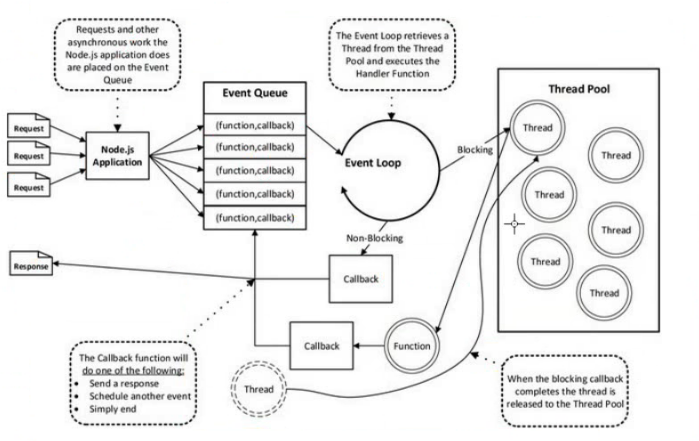Node.js 是一个基于 Chrome V8 引擎的 JavaScript 运行环境。
进程
1.process.argv 用于获取当前进程信息0--node.exe的目录
1--js文件的目录
2--第一个参数
process.argv.slice(2) 获取从第一个参数开始的参数
2.process.env 获取当前系统的环境变量
3.process.stdout.write('xxx')
console.log('xxx') = process.stdout.write('xxx ');
4.process.stdin.on('data',function(data){
process.stdout.write(data);
})
//回车时触发
传统的java,.net遇到阻塞io时会创建新的线程来处理。 node内部实现其实也是多线程的,(通过线程池)
//
多线程都是‘假’的,对于一个cpu核心。创建线程需要时间,线程数量有限,cpu在不同线程间切换需要转换上下文,耗费时间
多线程的意义并不大(多核心cpu则可能会提升效率)
node的主线程————事件队列与事件循环圈。

模块
exports的实现:
module是定义在.js文件中的对象
xxx.js
console.log(module)
....(打印出module对象)
module中有一个exports对象,可以向内添加属性和方法
(参考 https://www.cnblogs.com/wbxjiayou/p/5767632.html)
写一个require的实现:
function $require(id){
const fs = require('fs');
const path = require('path');
const filename = path.join(__dirname,id);
$require.cache = $require.cache || {};
if($require.cache[filename]){
return $require.cache[filename].exports;
}
const dirname = path.dirname(filename);
let code = fs.readFileSync(filename,'utf8');
let module = { id:filename,exports:{} };
let exports = module.exports;
code=`
(function($require,module,exports,__dirname,__filename){
${code}
})($require,module,exports,dirname,filename)
;`;
eval(code);
$require.cache[filename] = module;
return module.exports;
}
var m4 = $require('../xx.js');
m4.say();
...
清空require中的缓存机制:
Object.keys(require.cache).forEach((key)=>{delete require.cache[key]});
内置模块:
path:处理文件路径。
fs:操作(CRUD)文件系统。
child_process:新建子线程。
util:提供一系列实用小工具。
http:提供http服务器功能。
url:用于解析URL。
querystring:解析URL中的查询字符串。
crypto:提供加密和解密功能。
..
包(Node package manager):
Buffer
:读取文件时没有指定编码默认读取的是一个Buffer(缓冲区)
缓冲区:内存中操作数据的容器。
为什么要有缓冲区?
早期JS擅长处理字符串,及HTML文档,不会接触到二进制的数据。
而在Node中操作数据,网络通信是完全没法以字符串的方式操作的,所以在Node中引入了一个二进制缓冲区的实现,Buffer
//readfile的方式确实是使用buffer,但是也是一次性读取
Stream:
读一点数据,处理一点点数据(读到有限长的buffer中,然后再读取出来,)
写一个歌词滚动效果的实现:
假定有一个xxx.lrc文件
方法1.用buffer的方式读入fs.readFile(pathxx,callback)
在回调函数中对buffer进行tostring转换,然后split掉' ',对于数组中的每一行,用正则提取时间,然后settimeout按时间显示出来
(由于对每一行处理需要耗费几毫秒的时间,可以设置begin=new Date().getTime() 然后在后面的settimeout中设置新的new Date.getTime()-begin 减掉这个时间)
方法2.用stream的方式读入 var streamReader = fs.createReadStream(filename);
var data = '';
streamReader.on('data',function(chunk){ data+=chunk.tostring(); });
streamReader.on('end',function(){console.log(data); };
在这里对data进行处理
方法3.使用readline模块,用stream的方式读入 var streamReader = fs.createReadStream(filename);
var rl = readline.createInterface({ input:streamReader });
var begin = new Date().getTime();
rl.on('line',(line)=>{....对line进行处理})
写文件
默认写入是覆盖 ,可以使用append追加
方法1.fs.writeFile(path,callback);
方法2.var streamwriter = fs.createWriteStream(path);
streamwriter.write('xxx',callback) (以流的方式写入,防止在内存中读取过多)
其他文件api
检查文件、删除、重命名..
写一个目录树显示的实现:
思路:通过使用fs.readdirSync
网络框架
Express框架的核心是对http模块的再包装
var http = require("http");
var app = http.createServer(function(request, response) {
response.writeHead(200, {"Content-Type": "text/plain"});
response.end("Hello world!");
});
app.listen(3000, "localhost");
var express = require('express');
var app = express();
app.get('/', function (req, res) {
res.send('Hello world!');
});
app.listen(3000);
中间件(middleware)是处理HTTP请求的函数。
app.use("/home", function(request, response, next) {
response.writeHead(200, { "Content-Type": "text/plain" });
response.end("Welcome to the homepage!n");
});
app.use("/about", function(request, response, next) {
response.writeHead(200, { "Content-Type": "text/plain" });
response.end("Welcome to the about page!n");
});
app.use(function(request, response) {
response.writeHead(404, { "Content-Type": "text/plain" });
response.end("404 error!n");
});
http.createServer(app).listen(1337);
还可以这样写(*是指所有的请求都要先通过这个中间件)app.all("*", function(request, response, next) {
response.writeHead(200, { "Content-Type": "text/plain" });
next();
});
app.get("/", function(request, response) {
response.end("Welcome to the homepage!");
});
app.get("/about", function(request, response) {
response.end("Welcome to the about page!");
});
app.get("*", function(request, response) {
response.end("404!");
});